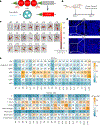Bone-marrow-homing lipid nanoparticles for genome editing in diseased and malignant haematopoietic stem cells
- PMID: 38783058
- PMCID: PMC11757007
- DOI: 10.1038/s41565-024-01680-8
Bone-marrow-homing lipid nanoparticles for genome editing in diseased and malignant haematopoietic stem cells
Abstract
Therapeutic genome editing of haematopoietic stem cells (HSCs) would provide long-lasting treatments for multiple diseases. However, the in vivo delivery of genetic medicines to HSCs remains challenging, especially in diseased and malignant settings. Here we report on a series of bone-marrow-homing lipid nanoparticles that deliver mRNA to a broad group of at least 14 unique cell types in the bone marrow, including healthy and diseased HSCs, leukaemic stem cells, B cells, T cells, macrophages and leukaemia cells. CRISPR/Cas and base editing is achieved in a mouse model expressing human sickle cell disease phenotypes for potential foetal haemoglobin reactivation and conversion from sickle to non-sickle alleles. Bone-marrow-homing lipid nanoparticles were also able to achieve Cre-recombinase-mediated genetic deletion in bone-marrow-engrafted leukaemic stem cells and leukaemia cells. We show evidence that diverse cell types in the bone marrow niche can be edited using bone-marrow-homing lipid nanoparticles.
© 2024. The Author(s), under exclusive licence to Springer Nature Limited.
Conflict of interest statement
Competing interests
UT Southwestern has filed patent applications on the technologies described in this manuscript with X. Lian and D.J.S. listed as inventors. D.J.S. discloses the following competing interests: ReCode Therapeutics, Signify Bio, Tome Biosciences, Jumble Therapeutics and Pfizer Inc. D.R.L. is a consultant and equity holder of Beam Therapeutics, Prime Medicine, Pairwise Plants, Chroma Medicine and Nvelop Therapeutics, companies that use or deliver gene-editing or epigenome-modulating agents. M.J.W. is a consultant for GlaxoSmithKline, Cellarity, Novartis and Dyne Therapeutics. J.S.Y. is an equity owner of Beam Therapeutics. The remaining authors declare no competing interests.
Figures





References
-
- Blaese RM et al. T lymphocyte-directed gene therapy for ADA-SCID: initial trial results after 4 years. Science 270, 475–480 (1995). - PubMed
-
- Cowan MJ et al. Early outcome of a phase I/II clinical trial (NCT03538899) of gene-corrected autologous CD34+ hematopoietic cells and low-exposure busulfan in newly diagnosed patients with Artemis-deficient severe combined immunodeficiency (ART-SCID). Biol. Blood Marrow Transpl. 26, S88–S89 (2020).
MeSH terms
Substances
Grants and funding
- R01 HL156647/HL/NHLBI NIH HHS/United States
- 1R01 CA248736/U.S. Department of Health & Human Services | NIH | National Cancer Institute (NCI)
- R01 CA269787/CA/NCI NIH HHS/United States
- R01HL156647/U.S. Department of Health & Human Services | NIH | National Heart, Lung, and Blood Institute (NHLBI)
- I-2123-20220031/Welch Foundation
- 5R01EB025192-06/U.S. Department of Health & Human Services | NIH | National Institute of Biomedical Imaging and Bioengineering (NIBIB)
- CA269787-01/U.S. Department of Health & Human Services | NIH | National Cancer Institute (NCI)
- P30 CA142543/CA/NCI NIH HHS/United States
- 6629-21/Leukemia and Lymphoma Society (Leukemia & Lymphoma Society)
- P30CA142543/U.S. Department of Health & Human Services | NIH | National Cancer Institute (NCI)
- R01 CA248736/CA/NCI NIH HHS/United States
- SIEGWA18XX0/Cystic Fibrosis Foundation (CF Foundation)
- R01 EB025192/EB/NIBIB NIH HHS/United States
LinkOut - more resources
Full Text Sources
Medical
Molecular Biology Databases

